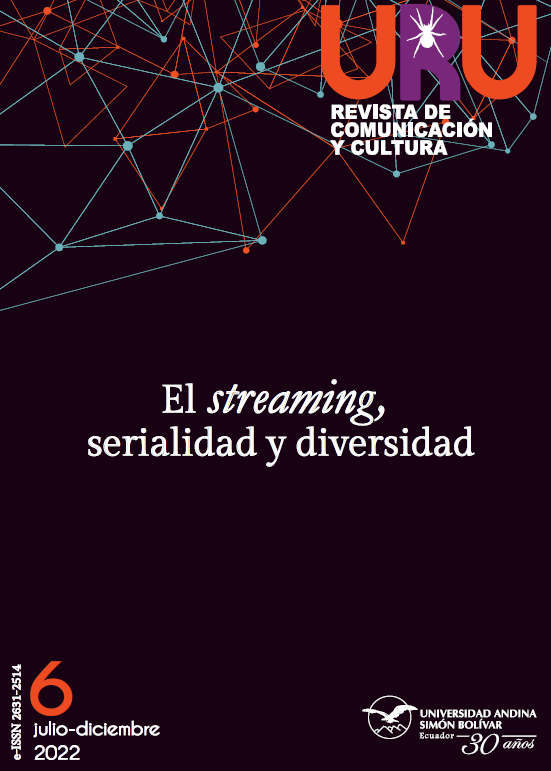Veneno como narrativa emergente de las plataformas de streaming y el renacimiento de un ícono de la comunidad LGBTI: Series de televisión como protagonistas del surgimiento y las memorias de personajes dentro de las narrativas audiovisuales
Contenido principal del artículo
Resumen
Veneno es una serie española creada por Javier Calvo y Javier Ambrossi, un biopic basado en la obra ¡Digo! Ni puta ni santa: Las memorias de la Veneno, escrita por Valeria Vega. El presente artículo analiza el influjo de la serie y la toma como ejemplo de narrativa emergente que posiciona y hace renacer a personajes icónicos de la comunidad LGBTI. Es el caso de Cristina Ortiz, la Veneno, actriz, celebridad, modelo, trabajadora sexual, vedette y una de las primeras mujeres en visibilizar a la comunidad trans en España, en los años noventa, desde la televisión. Gracias a la serie, este ícono renació para las nuevas generaciones, quienes conocieron su historia gracias a las plataformas de streaming. Asimismo, se realiza un acercamiento a las principales películas y series que abordan la temática transexual y/o incluyen personajes trans, para marcar un antes y un después desde la llegada de las plataformas de streaming y de la serie Veneno, que logró visibilizar la temática trans de manera trascendental.
Detalles del artículo
Sección

Esta obra está bajo una licencia internacional Creative Commons Atribución-NoComercial-CompartirIgual 4.0.
Los autores/as que publiquen en esta revista aceptan las siguientes condiciones:
- Los autores/as conservan los derechos de autor y ceden a la revista el derecho de la primera publicación, con el trabajo registrado bajo Licencia Creative Commons 4.0 de Reconocimiento No Comercial-Compartir Igual 4.0, que habilita a compartir, adaptar y atribuir el trabajo (ver: Políticas de acceso abierto).
- Los autores/as pueden realizar otros acuerdos contractuales independientes y adicionales para la distribución del artículo publicado en esta revista (p. ej., incluirlo en un repositorio institucional o publicarlo en un libro) siempre y cuando indiquen claramente que el trabajo se publicó por primera vez en Uru. En caso de reproducción deberá constar una nota similar a la siguiente: Este texto se publicó originalmente en Uru: Revista de Comunicación y Cultura N° --, año de publicación.
- Se recomienda a los autores/as publicar su trabajo en Internet (por ejemplo en páginas institucionales o personales) en la versión final publicada por Uru: Revista de Comunicaicón y Cultura ya que puede conducir a una mayor y más rápida difusión del trabajo publicado.
Cómo citar
Referencias
Carrión, Jorge. 2011. Teleshakespeare. Madrid: Errata Naturae.
Cinemanía. 2016. “David Lynch: ‘Las series son el nuevo cine de autor’”. Cinemanía. 23 de septiembre.
Farías, Laura. 2018. “Butterfly, el niño que solo busca ser Maxine”. El Gran Otro. 12 de noviembre.
Heredia, Verónica. 2017. “Revolución Netflix: Desafíos para la industria audiovisual”. Chasqui. Revista Latinoamericana de Comunicación 135: 275-95. DOI: https://doi.org/10.16921/chasqui.v0i135.2776
López, Joaquín. 2020. “Veneno, de HBO Max”. Milenio. 2 de septiembre.
Maguregui, Carina, Alejandro Piscitelli, y Carlos Scolari. “Prólogo”. En Lostología: Estrategias para entrar y salir de la isla, coordinado por Alejandro Piscitelli, Carlos Alberto Scolari y Carina Maguregui, 7-15. Buenos Aires: Cinema.
Manrique, Asier. 2020. “Ocho series que han dado visibilidad a personajes y actores trans”. El Diario Vasco. 14 de diciembre.
Ormeño, Carlos. 2019. “Límites de la transexualidad en el cine latinoamericano”. Ventana Indiscreta 22: 54-61. https://doi.org/10.26439/vent.indiscreta2019.n022.4664. DOI: https://doi.org/10.26439/vent.indiscreta2019.n022.4664
Palomo, Luisa. 2020. “Cinco personajes trans en series de televisión”. 35 Milímetros. 26 de marzo.
Percival, Ash. 2018. “‘Butterfly’ Writer on Changing Attitudes to Transgender Children and the Importance of Trans Representation on Screen”. HuffPost. 14 de octubre.
Sánchez, Guillermo. 2016. “La transexualidad en el cine español: Representación del personaje transexual en la ficción española”. Trabajo de investigación, Universidad de Sevilla, España.
Solà, Pere. 2020. “Las actrices de ‘Veneno’ han dado una lección a la industria televisiva”. La Vanguardia. 26 de octubre.


